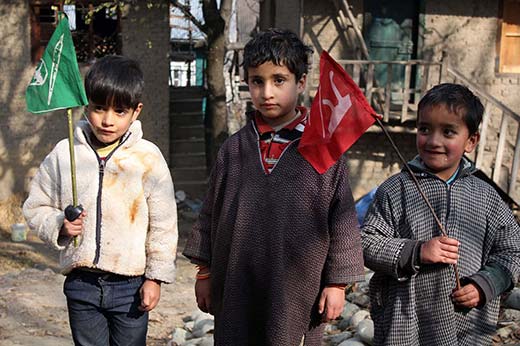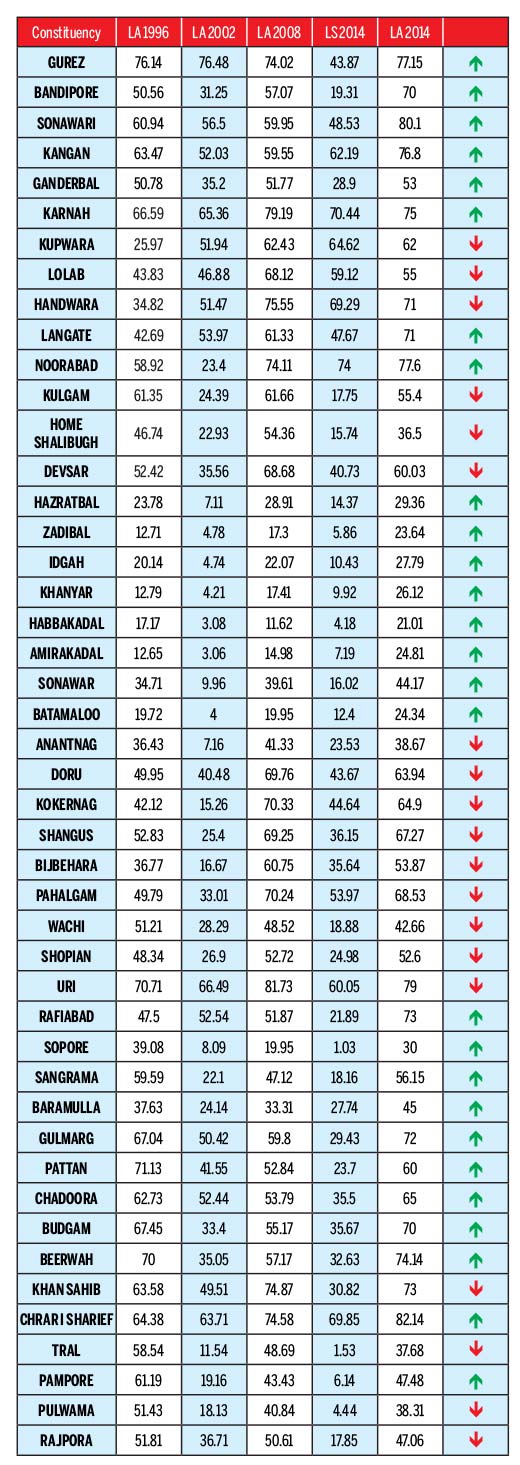As 28 of Kashmir’s 46 assembly seats improve their participation in the elections, academics and politicians interpret it differently. R S Gull analyses the trend that many think is a new to Kashmir’s ideological divide.

As participation in 2014 assembly polls improved phenomenally in the first phase, Prime Minister Narendra Modi said it was a clear rejection of the militancy. “People of J&K showed that finger on EVM is stronger than a finger on an AK-47 and have rejected the bullet by showing the strength of the ballot,” Modi said in Jammu on his second campaign visit.
The subsequent narrative that emerged at different levels suggested that the improved participation in the polling was necessarily the rejection of boycott that separatists usually sponsored. The argument was forcefully put forward despite the fact that most of the separatists who may have campaigned for a boycott were either in preventive arrest or under house arrest. In fact, the intensity of the boycott campaign, in anticipation of polls, was merely restricted to the statement they issued.
This argument even angered Chief Minister Omar Abdullah. “The mistake that we make is that we take an election, and consider it as a plebiscite,” Omar said in an interview. “It is not. It is an election.”
For Kashmir, every election is a new experience. Elections of 1987, 1996 and 2002 are complete exercises apart. But the 2014 poll is completely different and peculiar for a varied set of reasons. There were many local issues key to better participation, but the major one was that generated lot of heat and dust was BJPs Mission 44+.
It remained a win-win model for BJP. Though the avowed idea seemed they were keen to wrest power in J&K, the fear it created triggered a new consolidation forcing people out of their homes to vote. Even Omar admits: “In this election, the BJP has sort of helped the anti-boycott camp because the people have realized that some seats would otherwise be probably gifted to the BJP if they stayed in. BJP has really helped us in terms of galvanizing our National Conference cadre to come out and work.”
BJP invested massively in its plan. Even in Kashmir, where it lacked any base, the party was more visible than the local forces. From newspapers to the roads, the BJP was no obvious that for a moment, it seems as if it was marching towards the civil secretariat. Given the party’s baggage on Kashmir, it triggered panic within and outside.
Read with Subramanian Swamy’s assertions, doing away with the state subject mechanism, fiddling with otherwise hollow Article 370 and getting ex-servicemen to live on the borders, created sort of panic.
Political grapevine is that even Islamabad was so desperate to see more people voting in Kashmir fearing the BJP might achieve its ambitious target and end up erasing all exclusivities making J&K a distinct part in Indian federation. This is considered a main factor for the lowest ever poll-related violence in democracy’s post-1996 history.
With these apprehensions in mind, local players PDP and NC took the case to the people and it became part of the electoral discourse. The tensions created such a chain reaction that even Amit Shah, BJPs national president was forced to state in Jawahar Nagar that people need not to panic.
“Political parties here have created a scare among people that if BJP comes to power, it will do this, it will do that,” Shah told in his maiden speech in Srinagar to a small crowd, mostly non-voters, driven from the periphery and some women, in flood-devastated Jawahar Nagar. “This is all emotional blackmail. What will BJP do? It will do what they (local parties) have not done in sixty years.”
Given the fact that BJP was targeting three low-polled boycott seats, the people came out and reversed the trend. In such a fierce reaction, the party even could not make the migrant vote a major force in Habbakadal. After the four phases were over, the party started facing the music in Jammu where NC, Congress and PDP started telling people that since BJP has failed to make an account in Kashmir, why should Jammu vote to send its representatives to occupy opposition benches and not the treasury berths?
It is clear that BJP is emerging as the second largest political party. While there is still a possibility of the party joining the power structure in an alliance, it is now sure that they can not lead the government. But that does not reduce the importance of BJPs Mission 44+ which many think was a “political psy-op”. At the end of the day, even if the BJP fails to wrest the “Srinagar” throne, it still gave its government in Delhi an idea for a new claim: it improved participation and ensured peaceful conduct of polls.
The participation did not improve phenomenally. Only 28 of 46 seats have some sort of improvement. The most impressive shift was seen in Srinagar city’s eight seats which improved its tally. Compared to 2008, south Kashmir and parts of north Kashmir reduced their earlier record. If calculated as a single unit, Kashmir was more on boycott than participating in the elections. (See Table) But change it was and that was clear and loud.
BJPs “Mission” apart, there were a number of other reasons that led people to the polling stations. Voters who were interviewed by reporters across Kashmir in four phases were all talking about development – the roads, jobs, electricity, food and other things. This has been the old language that voters believe is politically correct.
The fact is that there has not been any government that has not its own contribution to the development – small or less. The NC government of 1996-2002 almost rebuilt Kashmir. Devastated by militancy and counter-insurgency, Dr Farooq Abdullah’s government rebuilt roads, buildings and reconstructed bridges. But when it came to polling in later 2002, it had given in a lot of its credibility. J&K reduced the party’s footprints from 57 seats in 1996 to 28 in 2002.
In both the elections – the 2002 and now in 2014, the key factor that played a key role in altering the balance at ground zero was the human rights, an issue that has singularly helped PDP throughout. The 2010 unrest in which Kashmir lost more than 120 youth played a major factor, especially in Srinagar city.
For the 2010 unrest, the army punished its members who were found responsible for the fake encounter of Macchil, the basic to the unrest. Omar Abdullah led coalition government avoided any intervention. Even four years after the Tufal Matoo murder is yet to be formally proved a killing by cops because the systems in place used every means to frustrate the process. While the government lacked any AFSPA to act against the men, it might have found guilty, it still skipped the issue. The only intervention was announcing a Commission on Inquiry after the party faced a debacle in Lok Sabha – an initiative that may never reach any conclusion.
The use of new crowd management systems created a new breed of victims including the blind youth. It strengthened the anti-incumbency wave against the government.
It was in this era when historic floods inundated Kashmir, especially Srinagar. The government inaction added to the crisis and helped many others to get formally introduced. Some of them might well end up in the assembly.
Opposition parties are talking about corruption but all governments have had their share in it. While it is a fact that Congress used its Jammu lawmakers to exploit the overall resource available with the state and Omar could not do much, he himself was inaccessible, at one point of time, to even his own party. And then, do not forget the money power that played a contributor at least in Srinagar.
















